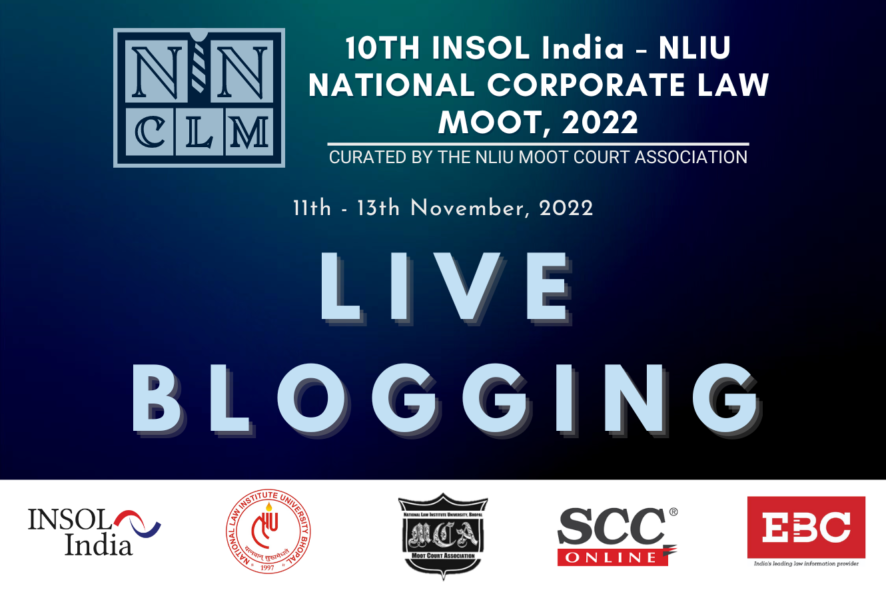The National Law Institute University, Bhopal, established in 1997, has been consistently accredited as one of the leading legal institutions of the country and has gained its stature as a reputable institution in the global legal arena. The University has shown active interest in the field of mooting so as to inculcate the art of research and drafting among the students. The Moot Court Association (“MCA”) of the National Law Institute University (“NLIU”) is the official student body which oversees all mooting and related activities in which the institution participates as well as the activities which are hosted on the campus. The MCA, established in 2002, is the oldest association of the Institute and has been working consistently and tirelessly for the welfare of the students of NLIU. It gives students a plethora of opportunities to explore and participate in a number of mooting and co-curricular activities. It organises various events of eminence, such as the NLIU-Justice R.K. Tankha Memorial International Arbitration Moot, the INSOL India – NLIU National Corporate Law Moot Court Competition, and the NLIU-Link Legal National Client Counselling Competition. Additionally, it provides a plethora of opportunities for its students to participate in moot court competitions across the world, and the same has yielded great achievements for the Institute.
NLIU MCA revives the legacy of the NLIU National Corporate Law Moot (“NNCLM”) by presenting the 10th edition of the INSOL India – NLIU National Corporate Law Moot, 2022, with this edition being the first to be conducted offline since the pandemic. The 10th edition of the moot is filled with a new guiding force and is backed by unprecedented enthusiasm of participants from leading law schools of India and professionals from various law firms of India.
About the Moot
The NLIU National Corporate Law Moot is our flagship event based on Indian corporate laws. Previously, the competition has been conducted in collaboration with various government institutions such as the Insolvency and Bankruptcy Board of India (IBBI) and the State Bank of India. The competition receives an outpouring response from leading law schools across the country every year.
This year, the moot is being organized in collaboration with INSOL India as the official name partner of the competition. It is an independent leadership body representing professionals specialising in restructuring, insolvency, turnaround and related areas. It has a particular focus on insolvency practice and continuing professional education in the country. INSOL India is playing a pivotal role in shaping a robust insolvency regime in the country as a result of the recent large-scale insolvency reforms. We also have SCC Online, a comprehensive database for legal research, as the official knowledge partner of the competition.
The Top 12 teams with the highest marks in their respective memorials, after having qualified through rigorous Memorial Qualifying Rounds, have been invited to compete in the oral rounds of the competition physically!
The competition officially commences today, keep checking this space for live updates!
11th November 2022- Day 1
3 PM | Registration | Auditorium
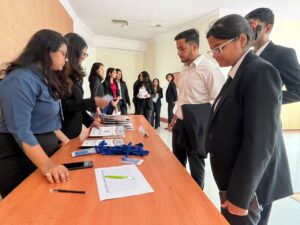
The registration formalities began at 3 pm sharp in the college auditorium. Teams from various colleges ranging from RMLNLU to Delhi University have arrived. The teams receive their respective moot kits from the organising committee. The process has come to a close, and the teams are making their way to their seats for the opening ceremony
4:15PM | Opening Ceremony & Academic Session | Auditorium
The opening ceremony begins with an introduction to the competition by the speaker Ms. Kumkum Suneja. Teams from various colleges are warmly greeted, and the session on the Overview of Resolution Process under the Insolvency Bankruptcy Code by Ms. Mahima Singh and Mr. Nikunj Solanki is underway. Ms. Mahima Singh, a Managing Associate at Chandhiok & Mahajan, is currently engaged in providing end-to-end legal support services (advisory and litigation) to resolution professionals. Mr. Nikunj Solanki is currently a Director at Ernst & Young and has sound experience in areas of Insolvency and Bankruptcy, Corporate Debt Restructuring, Turnaround and Cost Optimisation and Strategy Consulting.
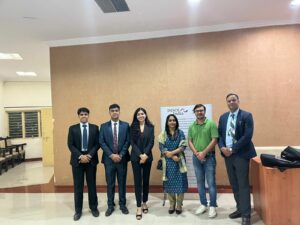
Ms. Mahima starts by explaining the basics of the Corporate Insolvency Resolution Process (CIRP) and who all are eligible for initiating the process, namely the Financial and Operational Creditors, along with the Corporate Debtor itself. She explains the role of the Interim Resolution Professional (IRP) and the Resolution Professional (RP). A question from the audience arises inquiring what the difference between the two is, to which it is explained that both have similar roles, with the only exception being that an IRPs role is temporary in nature. It is also explained that in most cases, the IRP himself gets appointed as the RP. The primary role of both is to keep the management of the company as a ‘Going Concern’.
The session is quite interactive and one of the participants asks “ Can a PRA can be rejected by the CoC for reasons other than those provided under section 29A?”, the answer to which is that a CoC does not have the discretion to appoint a Resolution Applicant and if rejected they have the right to challenge the decision.
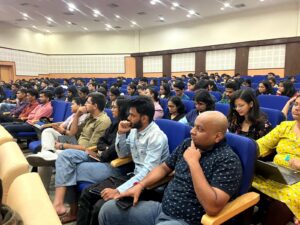
Another question from the audience is asked, “What is the procedure when a company fails to resolve itself after CIRP has taken place multiple times?” The answer given by Mr. Nikunj, is that the Resolution Applicant might face punishment if his plan fails to resolve the company. However if the plan fails due to bona fide reasons such as market conditions, then the company would most likely face more rounds of CIRP.
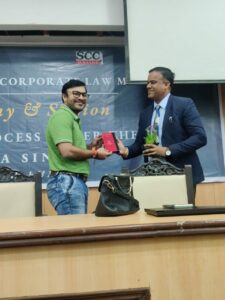
Mr. Nikunj concludes by sharing his experience in the field and by discussing the important aspects of IBC apart from the CIRP, such as pre-packed insolvency for smaller debts for a quick resolution, the field of cross-border insolvency and the field of personal insolvency.
A vote of thanks Is given to Ms. Mahima and Mr. Nikunj, saplings, as well as a commemorative copy of the Indian Constitution is presented to them by Asst. Prof. Amit Pratap Singh, as a form of appreciation and gratitude for the engaging and helpful session. The session comes to a close with a group photograph of all the participating teams.
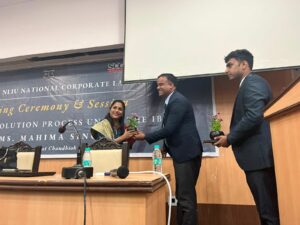
6:15 PM | Announcement of Fixtures and Exchange of Memorials | Auditorium
The fixtures for the preliminary rounds are announced, and the memorial exchange takes place. The Teams are given their opposing team memorials to refer to and use to prepare arguments against. The Participants, full of enthusiasm, eagerly wait for the upcoming events scheduled for tomorrow!
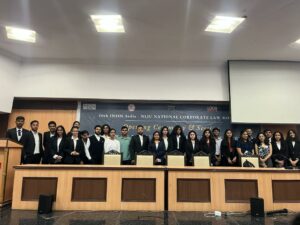
12th November 2022- Day 2
10 AM | Judges’ Briefing| NLIU Guest House
Day 2 of the event begins with a judges’ briefing session. The fixtures of the judges for the preliminary round 1 are disclosed by the Joint Convenor of the NLIU Moot Court Association, Mr. Vikramaditya Sanghi. The drafter of the problem, Mr. Hardik Jain, Associate, DSK Legal begins by sharing the journey of drafting the problem and goes on to quickly explain the facts and the four issues of the problem in brief. The judges are instructed about the points that must be borne in mind by them while they score the participants.
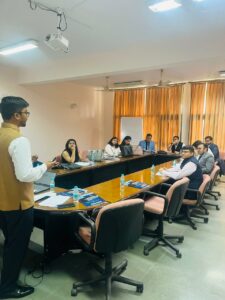
11:25 AM | Preliminary Round 1| Academic Block -1
1. Court Room 1– RMLNLU v MNLU Nagpur
The judges of the round are Mr. Ronak Jain and Ms. Mahima Singh. They begin the round by granting the applicants permission to present their arguments. They contend that the CoC should be given the power to reconsider the plan given by Tattooine as the transaction of the spectrum was invalid. The Judge questions the second speaker on the loss of the statement of consideration amount given by one party, and how the plans vary. The respondents contend that the dispute raised is frivolous in nature as a bid to avoid payment. They further argue that the allegation of confidentiality breach given by the applicants are baseless. The round was closed after constructive feedback was provided by the judges.
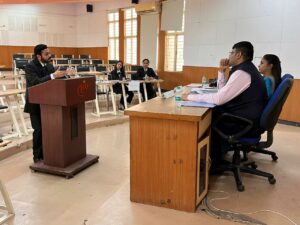
2. Court Room 2– HPNLU v NLUO
The Judges of the round are Ms. Nayani Agarwal and Mr. Kaustubh Rai. The round begins with Speaker 1 of the applicant’s side at the outset being quizzed by the judges on whether she would be permitted to represent multiple parties with conflicting interests as an advocate. During the respondent’s submissions, an intense discussion begins on the SC case of State Tax Officer v Rainbow Papers Limited, with the counsel trying to prove the applicability of this case in their favour. The round was closed after an intense round of rebuttals.
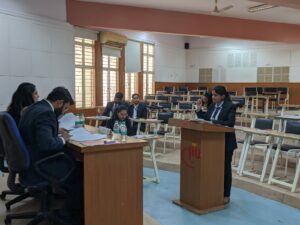
3. Court Room 3– RGNUL v NLU Sonepat
The judges of the round are Ms. Srideepa Battacharya and Ms. Shivani Kannojiya. The round starts with the applicants contesting that the license to the 5G Spectrum cannot, directly or indirectly, be assigned or transferred prior to the approval of the resolution plan by the adjudicating authority the CoC and the CoC has the right to sell it as it is an asset. They were then questioned on the facts and judgment of the Ebix Singapore case. The respondents start off with their arguments stating that there was no ‘dispute’ to start with contest that CoC approved resolution plans are binding in nature. The speakers being well versed with the facts impresses the judges and gives the clarity regarding the issue. In their feedback, the judges were appreciative of both teams and commended their originality of arguments.
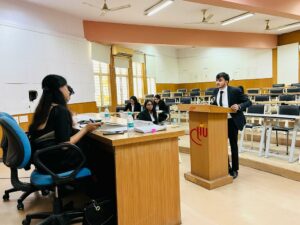
4. Court Room 4– Law Centre 2 v SLS Pune
The Judges of the Round are Ms. Radhika Indapurkar and Mr. Nikunj Solanki. Appellants begin to present their arguments . The respondents start off by defining a service as per the Consumer Protection Act, and use this definition to contend how there was a service provided by the respondent. The judges engage in a rigorous round of questioning regarding the distinction between an intangible asset and a right to use. In their feedback, the judges commend the team’s structure of arguments. They conclude by wishing the teams best of luck for all future rounds and competitions!
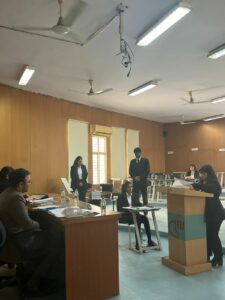
5. Court Room 5– TNNLU v Bennet University
The Judges of the round are Mr. Sumant Agarwal and Mr. Apoorv D. The applicants submit their arguments and are questioned on the facts and judgments of the cases by cited by them. The respondents present a compendium of authorities cited by them. The counsel bases their argument on the delay in payment being caused due to the pandemic and is questioned regarding the timeline of the payments and defaults. Since the counsels from both sides are presenting arguments issue-wise, after the first issue has been argued by both parties, the applicants again approach the dias for the second issue. The commercial wisdom of the CoC is discussed. Rigorous rounds of questioning follow in which the researchers were consulted. The following rebuttals are regarding whether an acceptance of the payment of one instalment amounts to acceptance of the entire transaction.
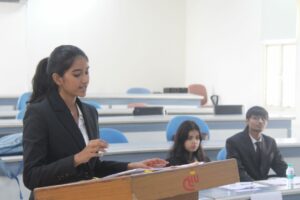
6. Court Room 6– SLS Noida v Institute of Law Nirma University
The Judges of the round are Mr. Amit Pratap Singh and Mr. Akshay Sharma. The applicants begin their arguments with an introduction to the facts of the case, over which they face questioning by the judges. They were grilled on the provisions of the IBC, and relevant landmark judgments were discussed. The respondents faced similar questions.
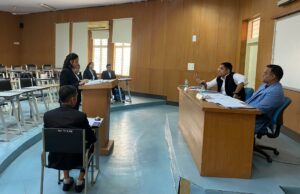
3 PM | Preliminary Round 2 | Academic Block -1
1. Court Room 1- NLUO v SLS Noida
The judges of the round are Mr. Ronak Jain and Mr. Manav Tanwani. The round starts with the applicants being questioned on the powers and functions of the CIRP. The counsels for the respondents are asked whether the judgments cited by them applied to the case at hand. They claimed that there existed no pre-existing dispute and was contended by the applicants only to respond to receipts by Naboo. The proceedings end with the judges admiring the innovation of arguments of both parties.
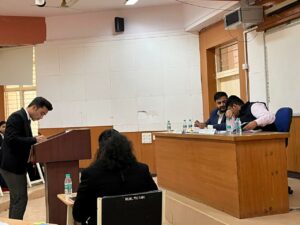
2. Court Room 2– MNLU, Nagpur v RGNUL
The judges of the round are Mr. Kaustubh Rai and Ms. Nayani Agarwal. The round begins with the judges sharing their opinion with the applicants that the present case does not stand. The judges then ask the counsels if they can convince them otherwise. The counsel takes the defence of force majeure for non-payment of dues, but the defence is rejected by the bench. The counsel for the respondent relies on the triple test and argues that the petition under section 9 of IBC is maintainable. During the feedback, the judges share their satisfaction towards the submissions of both parties.
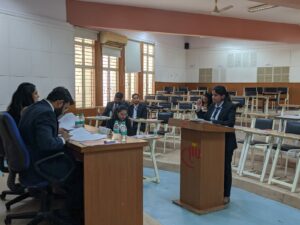
3. Court Room 3- SLS Pune v HPNLU
The rounds were judged by Ms. Srideepa Bhattacharya and Ms. Shivani Kannojiya. The rounds start with the applicants contesting that the CoC has the right to sell the corporate debtor’s assets. The Judges ask why the applicants should be given a special charge when alternative remedies are available. The respondents present their submissions stating that the claim fits all the requirements and aptly fits under section 9 of IBC. The respondents respond by saying that although the case was pending before the SC, the decision by NCLAT was given had some persuasive value. In their prayer, they ask that the bench dismiss all the applications and appeals as presented by the claimants.
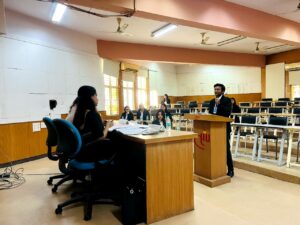
4. Court Room 4– Institute of Law, Nirma University v TNNLU
The judges for the rounds are Ms. Radhika Indapurkar and Mr. Nikunj Solanki. The argument begins with an explanation of the pre-existing disputes and the payment of the settlement agreement in installments. The judges ask if the Telegraph Act, or General Clauses Act, as cited by the counsels, will prevail over the IBC, to which the counsels shift to an argument reliant on the ‘right to review’ being an essential of the CoC’a commercial wisdom. The respondents now begin their submissions and extensively cover who an operational or financial creditor is, along with the resolutions dictating the trading of spectrum licenses and withdrawal of the resolution plan. The rebuttals start with the applicants claiming that the respondents had at multiple times contradicted their own stance, a claim that was vehemently denied by the respondents.
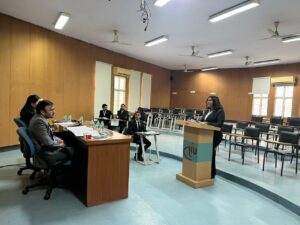
5. Court Room 5– NLU, Sonepat v Law Centre 2
The judges for the rounds are Mr. Sumant Agarwal and Mr. Apoorv D. The counsel for the applicants, begins her submissions with an introduction to the facts and then proceeds with the arguments. She was questioned on the facts of the judgments cited by her. The counsel for the respondents was initially asked to rebut the submissions of the applicant before proceeding with their submissions. The arguments for the respondents included contentions regarding ownership of the spectrum.
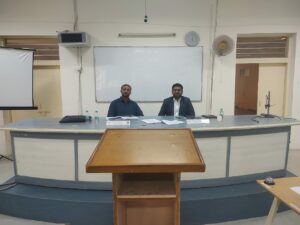
6. Court Room 6– Bennett University v RMLNLU
The rounds are being judged by Mr. Amit Pratap Singh and Mr. Akshay Sharma. The applicants begin their submissions with the contention that the NCLT and NCLAT had made an error in admitting the application. Both counsels are questioned on their knowledge of the relevant judgments and the provisions of the IBC. The respondent side starts by asking why there should not be a new settlement plan considered due to a potential fraud committed as confidentiality was breached. The counsel responds by saying that as Naboo devoted hours in preparing a resolution plan, and were very close to the liquidation value hence fraud cannot said to be involved. Feedback is provided regarding their submissions’ structure and praised them.
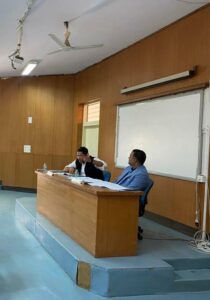
8 PM | Announcement of Breaks
The wait for results is over! Here are the teams that have qualified to the semi-final rounds due to take place tomorrow.
- National Law University Odisha (TC 05) v Institute of Law, Nirma University (TC 01).
- Rajiv Gandhi National University of Law (TC 11) v Dr. Ram Manohar Lohia National Law University, Lucknow (TC 20).
A coin is tossed, and the winning teams get the opportunity to choose which side they are to represent. Once the sides have been finalised, the memorials of the teams are exchanged, and the qualifying teams are already hard at work for tomorrow’s rounds!
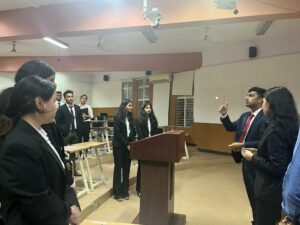
13th November 2022 -Day 3
10:30 AM | Judges’ Briefing| NLIU Guest House
The briefing starts with Ms. Khushbu Turki and Mr. Vikramaditya Sanghi, the joint conveners of the MCA, clarifying the rules of the moot. Mr. Hardik Jain, co-drafter of the moot problem, briefs them on the background of the problem, and the judges partake in a discussion regarding the issues and their opinions of the same. The judges are provided with the scoresheets and were briefed on the pattern of marking. The briefing concludes, and the judges proceed to the academic block for the rounds.
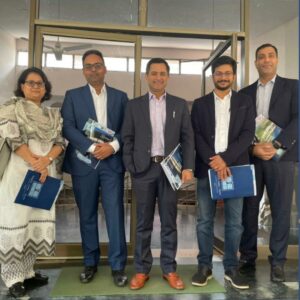
11 AM | Semi-Final Rounds | Academic Block -1 –
Court Room 1-RGNUL v RMLNLU
The judges for the semi final rounds are Mr. Siddharth Srivastava and Mr. Bishwajit Dubey. The rounds start with the applicants contesting that the license to use 5G spectrum cannot directly or indirectly be transferred without the payment of AGR dues. The judges ask if the nature of the debt is not operational, then what form of debt is it to which the counsel answers by classifying the debt as an outstanding one, carried forward by the Master-Service Agreement, and the operational nature of debt was no longer applicable.
The respondents begin their submissions by contending that there indeed exists an ‘operational debt’ contrary to claims of the opposing counsel. The judges ask how section 29A is applicable in the present circumstances, in response to which the counsel explains the given provision and how eligibility criteria given under section 29A was applicable. The rebuttal rounds begin with a dialogue about the resolution plan not being a settled proposal, therefore extending the applicability of section 29A, to which it is countered that the case presented was not for literal interpretation of the given section but for the objective of the proposed interpretation.
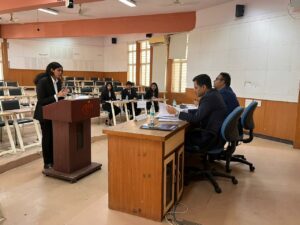
Court Room 2- Institute of Law, Nirma University v NLUO
The judges of this round are Mr. Saurav Panda, Mr. Sandeep Bajaj and Miss Shweta Dubey. The applicant begins deliberation by stating the legal and general facts of the case. A hypothetical question regarding underlying payment obligation is posited and the applicants are grilled on the application of section 9. The judges further grill the counsel on whether the license of using the spectrum is an asset or not. The bench also interrogates the counsel on why Section 29(a) is not applicable in the present case, to which the counsel replies that it is applicable only on Resolution Plan.
The respondents begin their arguments by proporting that the NCLT and NCLAT committed no error, and substantiate their argument to the same, however the judges quiz the counsel on whether the NCLT is a suitable forum to adjudicate the present issue. To this, the counsel draws a comparison to a case of the Supreme Court and answers in the affirmative. The counsel cites the ‘doctrine of legitimate expectation’ and ‘doctrine of promissory estoppel’ and other such doctrines to further analyse their claims. They assert that section 29A is a “see-through provision” contending that the power to reconsider by the CoC under the garb of goodwill cannot apply here. The bench questions the applicability of Section 14(1)(b) given that they acknowledge prior that the approval hasn’t stayed.
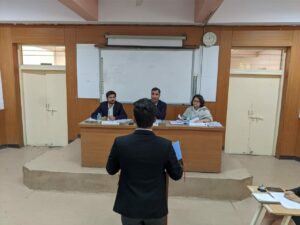
2:30 PM | Judges’ Briefing| NLIU Guest House
The session begins with an explanation of the problem by Mr. Hardik Jain, the co-drafter of the problem. He explains the journey of the problem followed by facts of the case in question. The judges engage in a discussion of the applicable judgments and the facts of the case. An explanation of the format and rules of the competition is followed by the suggestion that the rounds take place in an issue-wise fashion, and the briefing concludes with an explanation of the system of scoring.
2:45 PM Time | Results of Semi-Finals and Memorial Exchange
The breaks for the semi-final rounds are
- Dr. Ram Manohar Lohia National Law University (TC 20) v Insititute of Law Nirma University (TC 01)
The memorials are exchanged, and the teams fervently begin preparing for the final rounds.
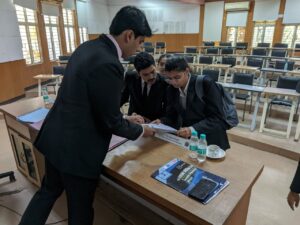
3 PM | Final Rounds | Auditorium- Dr. Ram Manohar Lohia National Law University v Institute of Law Nirma University
The final rounds are judged by Mr. Narendra Kumar Bhola (Former Member of NCLT), Mr. Dinkar Venkatasubramanian (India Head Turnaround & Restructuring strategy, EY India Board Member, INSOL India), and Ms. Pooja Mahajan (Managing Partner, Chandhiok & Mahajan).
The rounds are arranged in such a manner that each issue is to be argued for and against consecutively. Issue 1 pertains to the question if Section 9 of IBC is maintainable for default of debt arising from a Settlement Agreement that was entered to allow the Corporate Debtor the benefit of making staggered payments. The applicants state that the NCLT and NCLAT erred in the filing of the section 9 petition while the respondents opposed this contention and furthered their arguments with various submissions The judges ask questions regarding the breach of the invoice and the existence of a pre-existing dispute along with the validity of precedents and judgments cited. The respondents begin by defining an operational debt and state that the service of laying down optic fibres does not change the nature of the debt just because of the existence of a service agreement. They also contend that there was no pre-existing dispute. The applicants are given an opportunity to present a rejoinder, in which they discuss how through an application under Section 9 of the IBC, they had restricted themselves from gaining benefits. The reply to the rejoinder by the respondents alleged that the applicants were employing dilatory tactics, and the inability of the party to fulfil their commercial and debt obligations implied they require the cure of the IBC.
For issue 2, the counsel for the applicant begins by contending that the license to use the 5G spectrum cannot be directly or indirectly transferred unless the entire dues that are owed are paid to the DoT. It is further argued that the 5G spectrum is a finite and natural resource of which the government is the trustee. The counsel, therefore, contends that the spectrum cannot be transferred. The counsel for the respondent begins by arguing how the spectrum can be transferred irrespective of the clearance of the dues. Moving forward with the third issue, the judges quiz the counsel on the relevance of the Ebix Singapore judgment in the present case. The counsel from the respondent side presented her. The counsels then begin presenting their arguments for issue 4. The respondents argued by explaining how the CoC’s resolution plan is disguised as a settlement proposal. Once both sides have satisfied the judges with their arguments, they proceeded with their prayers. After two long hours of arguing and rigorous questioning, the finals are finally over! The Judges are now scoring the participants and the result is much awaited.
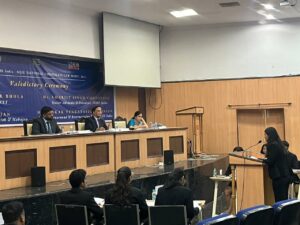
5 PM | Awards and Valedictory Ceremony | Auditorium
Brief on Addresses by the Dignitaries-
The valedictory ceremony starts with the judges being presented with saplings and a copy of the Indian Constitution.
The Hon’ble Vice Chancellor V. Vijayakumar addresses the gathering and appreciated the students for making the judges time here meaningful.
Mr. Dinkar Venkatasubramanian is next on the dais and iterates that the Insolvency laws have done well and come a long way, all thanks to the IBC. He commends the moot proposition drafted by the drafters reminiscent of all the issues in the IBC today.
Ms. Pooja Mahajan was impressed with the teams and their confidence and mentions how difficult it was to declare the winner of the competition. She shares how insolvency intrigued her since her days at Oxford.
Lastly, Mr Narender Bhola appreciates the concept of moot court as being extremely relevant and found both teams quite energetic and well informed along with possessing proper court etiquette.
The time is for the valedictory ceremony for the 10th INSOL India – NLIU National Corporate Law Moot. The guests for the ceremony are Mr. Narendra Kumar Bhola (former member, NCLT), Mr. Amarjit Singh Chandhiok (Senior Advocate & President, INSOL India), Ms. Pooja Mahajan (Managing Partner at Chandhiok & Mahajan) and Mr. Dinkar Venkatasubramanian (Head-Turnaround & Restructuring Strategy, EY India).
The ceremony started off with presenting mementoes to our guests followed by an address by our Vice-chancellor. He started his address by highlighting the importance of co-curricular activities like mooting, he was reminiscent of his college days when such activities were not there which reiterated the benefits of such activities. He also invited judges to be professor-in-practice at NLIU which is a new addition by the NEP.
Mr. Chandhiok gave thanks on behalf of INSOL for this tie-up with NLIU.
Mr. Venkatasubrimanian started by highlighting how IBC is not more the first resolve for insolvency problems but IBC is important for ground-level uniformity and discipline. He then went on to commend the problem and the people who developed it. He wished best of the luck to the teams. Congratulated the participants for performing well and confidently. He also showed interest in making INSOL-organised moot courts a yearly affair.
Ms. Pooja congratulated the participants for performing well and commended them for being confident.
Mr. Bhola thanked everyone for being invited to this event and iterated how the teams had a neck-to-neck fight. He ended his address by wishing the best of luck to the students.
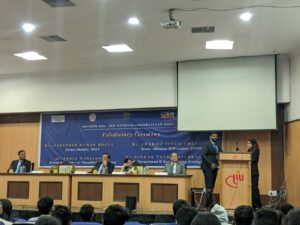
The awards for the competition are as follows
Best Oralist – Mayank Bansal ( Dr. B.R. Ambedkar National law University, Sonepat)
Best Appellant Memorial- Rajiv Gandhi National University of Law, Patiala.
Best Respondent Memorial – Dr. Ram Manohar Lohia National Law University, Lucknow.
Runners Up– Dr. Ram Manohar Lohia National Law University, Lucknow.
Winners – Institute of Law Nirma University.
The ceremony ended with an address from the Convenor of the Moot Court Association, Mr. Vikramaditya Sanghi. He extended a vote of thanks to judges, the participants and to everyone who supported in making this event a successful one.



